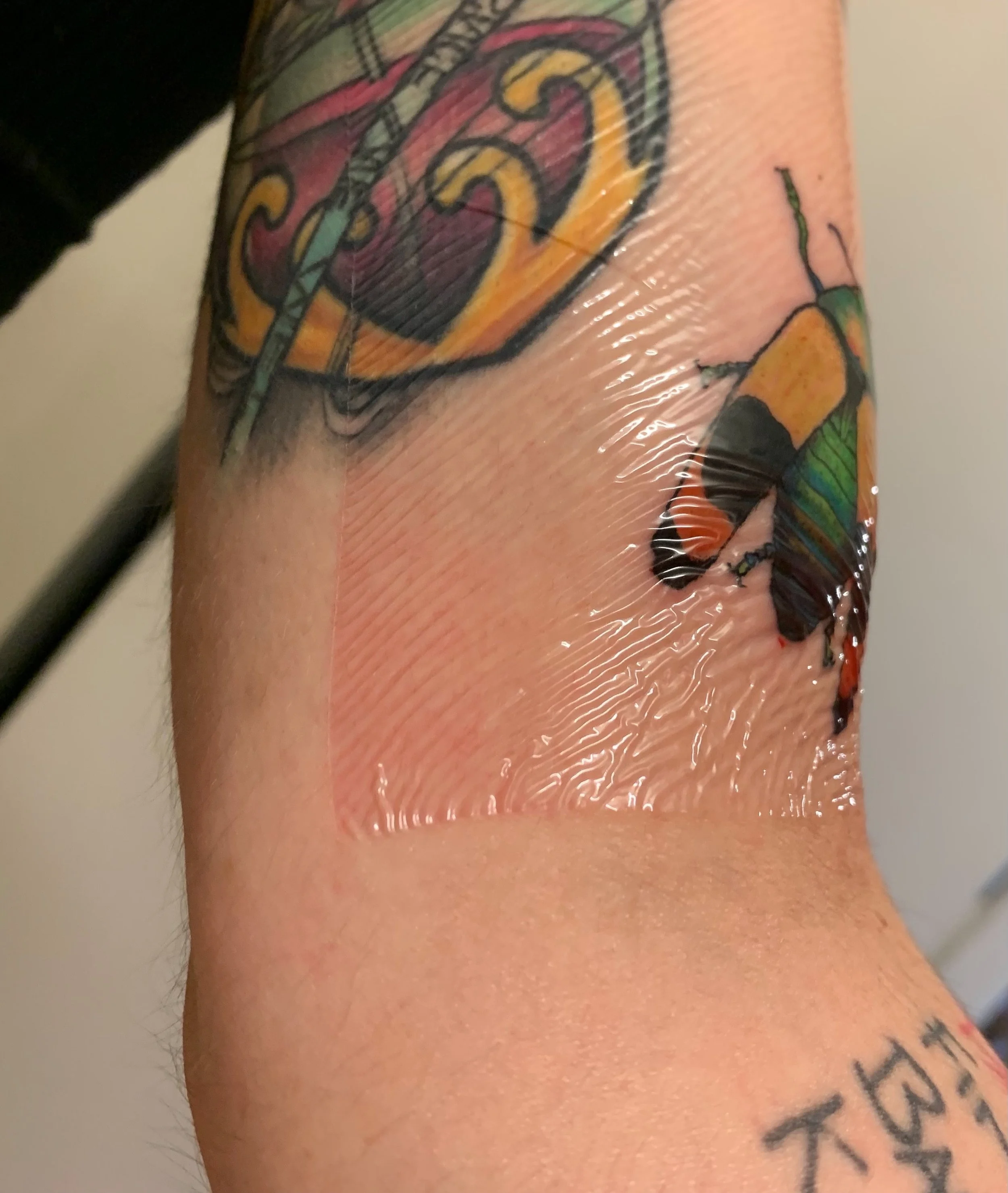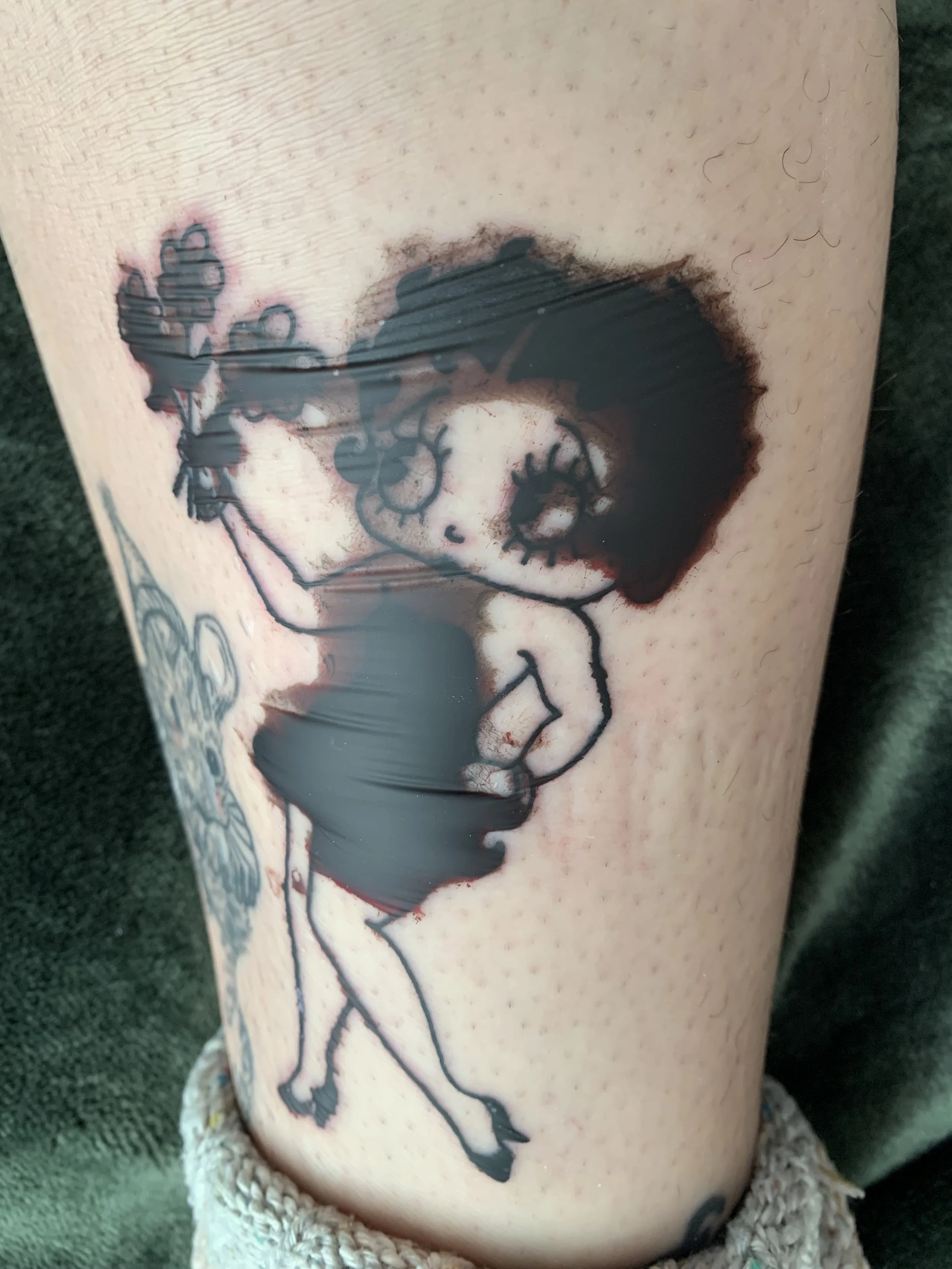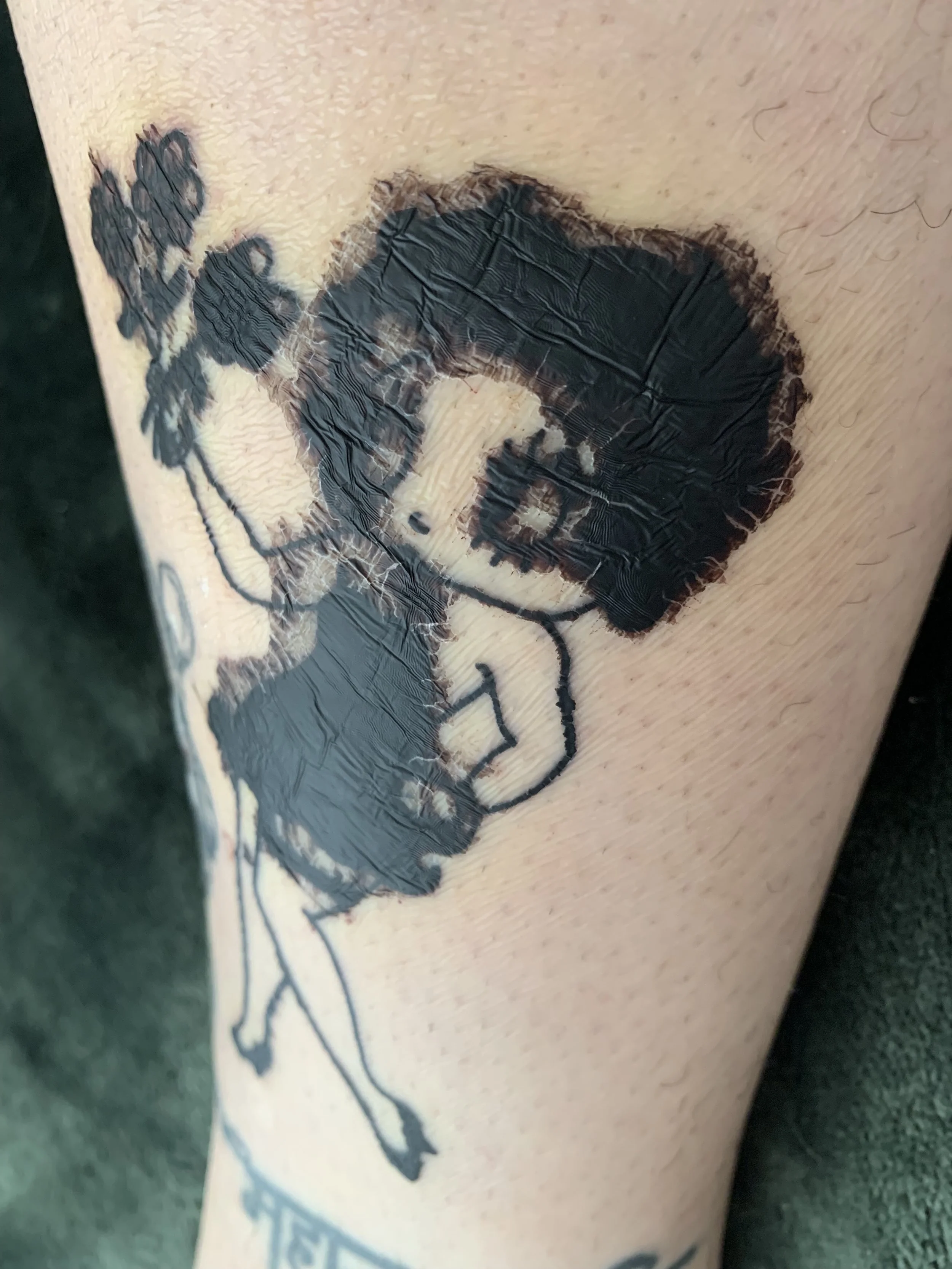Caring For
*Your Tattoo
-
Carefully remove the bandage and throw away. Clean the tattoo as outlined below. Moisturize with unscented lotion.
Optional: wear a comfortable, clean clothing layer over the tattoo for the first 1-2 days to protect from dirt and pet dander.
-
There is generally no need to re-apply a bandage after removing the initial one, whether a padded bandage or a clear adhesive bandage.
Some artists recommend removal of the bandage the day after the tattoo procedure, then immediately applying a new one. This is often recommended for tattoos with heavy, solid shading, as they will purge a lot more plasma and ink in the first few days. Since I mostly work with thinner-to-moderate lines and light shading, this is not typically necessary when healing pieces I’ve tattooed.
-
It's better to err on the dry side than the over-moisturized side! Use an unscented lotion and avoid thick, pore-clogging ointments like Aquaphor or Vitamins A&D ointment.
Your tattoo should be comfortably hydrated with the rest of your skin, typically needing 2-3 applications of lotion daily during the first 1-2 weeks of healing.
After 3-5 days, your tattoo may begin to peel and itch. Avoid picking & scratching, as it may damage the tattoo! Let the peeling areas slough naturally, and apply lotion to soothe itchiness.
If you notice after 7 days that areas of your tattoo remain gooey/wet, feel warm to the touch, or are red around the edges, email me immediately for aftercare assistance.
-
Most tattoos complete the healing process within 1-2 weeks.
Depending on the placement or amount of solid-ink areas in your tattoo, the upper surface of the tattoo may feel slightly wrinkly or wavy for a few weeks after your appointment. This is normal as the skin heals-- continue to moisturize with lotion.
Tattoos are generally considered fully healed after one year. Ink molecules are being suspended in your skin by your immune system, which means those molecules will shift under the skin over time. Aging is a natural and beautiful part of the tattoo process, and all tattoos will change as they live and grow with you over the years.
DAYS 1-2: Your tattoo will “weep” plasma and excess ink. Keep clean and lightly moisturize with unscented lotion.
DAYS 3-4: Tattoo may look wrinkly and dark as the top layer begins to pull away from the deeper layers that are now settling in.
DAYS 5-7: Upper layers of tattoo will start flaking and peeling off. Do NOT pick or scratch! Moisturize when itchy and let the tattoo slough on its own.
keep it clean
*
or else
*
keep it clean * or else *
Cleaning Your Tattoo
Rinse the unbandaged tattoo with clean, cool water.
Lather unscented antibacterial soap in your hands and move your fingertips in small circles across the surface of the tattoo.
Continue gentle cleaning until you no longer feel gelatinous residue anywhere on the tattoo. Rinse well.
Proceed with your shower routine, avoiding your tattoo. Rinse the tattoo again before exiting the shower.
Pat your tattoo dry with a clean paper towel. Do NOT use a towel or other woven material, as it can transfer bacteria. Allow to air out for 10-15 minutes.
With clean hands, apply a sheer layer of unscented lotion on the tattoo.
USING CLEAR ADHESIVE BANDAGES
-

ALLERGIES
If you notice redness or hives along the perimeter of the bandage, remove the bandage and clean the tattoo as outlined above. Moisturize with a thin layer of unscented lotion. Redness should subside within 24 hours, and any skin discoloration from contact with the adhesive should fade within 1-6 weeks.
If you notice continued redness, warmth to the touch, irritation, or white/yellow residue crusting on the tattoo, contact your primary care physician immediately. Most infections can be taken care of quickly with antibiotics.
-

DAYS 1-2
Over the first couple days, excess ink molecules, blood, and plasma will flood the surface of the tattoo, creating a liquid bubble beneath the adhesive. This is normal! The best thing you can do is leave it alone.
During this stage, keep an eye out for any punctures or leaking edges. If you notice any, remove the bandage completely and clean as outlined above, moisturizing with unscented lotion afterward.
-

DAYS 3-4
The liquid bubble should be reabsorbing into the skin, self-regulating the moisture levels of your tattoo. Once all the liquid has been absorbed, the bandage should have fully shriveled back down onto the surface of the tattoo, with no liquid movement under the bandage. At that point, it’s time for removal!
-

BANDAGE REMOVAL
With clean hands, roll up one corner of the plastic and slowly peel it back toward the tattoo. You can also pull it forward like a Command Strip-- whatever method is least painful!
Be careful not to remove the patch too quickly— tugging at the plastic can leave behind small specks of residue on the tattoo and surrounding skin. If this occurs, do not use any chemical adhesive removal on the skin, and do not scrub your tattoo! The adhesive bits will slough on their own, it just may take an extra day or two.
Once the bandage is fully removed, you can throw it away, wash your hands, and move forward with cleaning and moisturizing.
-

DAYS 5-7
Throughout the following days, the top layers of the tattoo may start to peel and flake. This is normal and an important part of the healing process— do NOT pick at it! Any of it! Leave Britney alone! Continue applying lotion when dry, and let the flakes slough naturally. It’ll totally flake onto your hands, but don’t freak out. Just make sure the lotion is rubbed into the tattoo, and then wash your hands.
The peeling stage should only last a few days. It’s gonna get itchy, but that’s a good sign! That means the deeper layers of skin are healing as the upper layers begin to shed. Do your best not to scratch— itching your tattoo as its healing WILL lift ink out of the skin! If you’re really struggling, try patting the tattoo with your fingertips or apply a fresh layer of lotion.
-

FOLLOWING WEEKS
While the tattoo is healing, DO NOT apply any sort of numbing cream, spray, or other numbing topicals. Numbing products applied to fresh or healing tattoos will chemically burn the skin, and your tattoo will burn off and likely become infected before scarring over.
Avoid prolonged exposure to bodies of water (baths, pools, hot tubs, lakes, rivers, etc.) for at least 3 weeks after receiving your tattoo. Submerging a fresh tattoo in any liquid greatly increases the chances of improper healing and infection that could lead to serious illness.
I also recommend waiting at least one week before engaging in physical exercise, whether at home or in a gym. Treat your healing tattoo like a burn or wound— give your body time to recover and accept the tattoo into your body, while avoiding opportunities for contact with public and/or infectious surfaces.
The better care you take of your tattoo while it’s healing, the better it’ll look in the long run!
These aftercare instructions are my own preference and opinion, as I do not claim to be an expert in skincare, esthetics, or dermal health. Though I consider these aftercare practices to be safe and successful for most skin types, contacting your dermatologist or PCP will always be the most effective choice if there’s reason for concern.
My Aftercare Office (me) is open 24/7 for questions regarding healing: tamponparty@gmail.com


